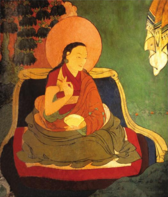
A | B | C | D | E | F | G | H | CH | I | J | K | L | M | N | O | P | Q | R | S | T | U | V | W | X | Y | Z | 0 | 1 | 2 | 3 | 4 | 5 | 6 | 7 | 8 | 9
| Part of a series on |
| Women in society |
|---|
 |
| Part of a series on |
| Buddhism |
|---|
 |
Women in Buddhism is a topic that can be approached from varied perspectives including those of theology, history, anthropology, and feminism. Topical interests include the theological status of women, the treatment of women in Buddhist societies at home and in public, the history of women in Buddhism, and a comparison of the experiences of women across different forms of Buddhism. As in other religions, the experiences of Buddhist women have varied considerably.
Scholars such as Bernard Faure and Miranda Shaw are in agreement that Buddhist studies is in its infancy in terms of addressing gender issues. Shaw gave an overview of the situation in 1994:
In the case of Indo-Tibetan Buddhism some progress has been made in the areas of women in early Buddhism, monasticism and Mahayana Buddhism. Two articles have seriously broached the subject of women in Indian tantric Buddhism, while somewhat more attention has been paid to Tibetan nuns and lay yoginis.[1]
However Khandro Rinpoche, a female lama in Tibetan Buddhism, downplays the significance of growing attention to the topic:

When there is a talk about women and Buddhism, I have noticed that people often regard the topic as something new and different. They believe that women in Buddhism has become an important topic because we live in modern times and so many women are practicing the Dharma now. However, this is not the case. The female sangha has been here for centuries. We are not bringing something new into a 2,500-year-old tradition. The roots are there, and we are simply re-energizing them.[2]
Masatoshi Ueki conducted a comprehensive evaluation of the status of women and gender equality in Buddhism, which was grounded in a diachronic textual analysis of Buddhist literature from Early Buddhism to the Lotus Sutra. Ueki employed a nuanced interpretation of the terms 'male' and 'female' beyond mere biological characteristics, instead emphasizing their functional roles within society, which he referred to as the 'male principle' or Yang qualities and 'female principle' or Yin qualities. His investigation culminated in the conclusion that Shakyamuni's teachings make no distinction regarding women's enlightenment, thus asserting gender equality in Buddhism.
The establishment of the male principle in equal measure with the female principle is the natural order of things. They should never exist in a mutually exclusive relationship. They should not be an emphasis on one at the expense of the other, for both are indispensable. ... will the establishment of the true self be a fact of reality for both men and women.[3]
Timeline of women in Buddhism
- 6th century BCE: Mahapajapati Gotami, the aunt and foster mother of Buddha, was the first woman to receive Buddhist ordination.[4][5]
- 5th century: Prajñātārā was the twenty-seventh Indian Patriarch of Zen Buddhism and teacher of Bodhidharma.[6] While Prajñātārā has generally been assumed to be male and is listed among the Chan Patriarchs (all of whom are male), 20th century Buddhist practitioners have suggested that Prajñātārā might have been a woman.[7]
- 13th century: The first female Zen master in Japan was the Japanese abbess Mugai Nyodai (1223–1298).[8][9]
- 1880: Madame Blavatsky and Colonel Olcott became the first Westerners to receive the refuges and precepts, the ceremony by which one traditionally becomes a Buddhist; thus Blavatsky was the first Western woman to do so.[10]
- 1928: A secular law was passed in Thailand banning women's full ordination in Buddhism. However, this law was revoked some time after Varanggana Vanavichayen became the first female monk to be ordained in Thailand in 2002.
- 1966: Freda Bedi, a British woman, became the first Western woman to take ordination in Tibetan Buddhism.[11]
- 1971: Voramai, also called Ta Tao Fa Tzu, became the first fully ordained Thai woman in the Mahayana lineage in Taiwan and turned her family home into a monastery.[12][13]
- 1976: Karuna Dharma became the first fully ordained female member of the Buddhist monastic community in the U.S.[14]
- 1981: Ani Pema Chodron is an American woman who was ordained as a bhikkhuni (a fully ordained Buddhist nun) in a lineage of Tibetan Buddhism in 1981. Pema Chödrön was the first American woman to be ordained as a Buddhist nun in the Tibetan Buddhist tradition.[15][16]
- 1988: Jetsunma Ahkon Lhamo, an American woman formerly called Catharine Burroughs, became the first Western woman to be named a reincarnate lama.[17]
- 1996: Through the efforts of Sakyadhita, an International Buddhist Women Association, ten Sri Lankan women were ordained as bhikkhunis in Sarnath, India.[18]
- 1996: Subhana Barzaghi Roshi became the Diamond Sangha's first female roshi (Zen teacher) when she received transmission on March 9, 1996, in Australia. In the ceremony Subhana also became the first female roshi in the lineage of Robert Aitken Roshi.[19]
- 1998: Sherry Chayat, born in Brooklyn, became the first American woman to receive transmission in the Rinzai school of Buddhism.[20][21][22]
- 1998: After 900 years without such ordinations, Sri Lanka again began to ordain women as fully ordained Buddhist nuns, called bhikkhunis.[23]
- 2002: Khenmo Drolma, an American woman, became the first bhikkhuni (fully ordained Buddhist nun) in the Drikung Kagyu lineage of Buddhism, traveling to Taiwan to be ordained.[24]
- 2002: A 55-year-old Buddhist nun, Varanggana Vanavichayen, became the first female monk to be ordained in Thailand. She was ordained by a Sri Lankan woman monk in the presence of a male Thai monk. Theravada scriptures, as interpreted in Thailand, require that for a woman to be ordained as a monk, the ceremony must be attended by both a male and female monk.[25] Some time after this a secular law in Thailand banning women's full ordination in Buddhism which had been passed in 1928 was revoked.
- 2003: Ayya Sudhamma Bhikkhuni became the first American-born woman to gain bhikkhuni ordination in the Theravada school in Sri Lanka.[26][27][28]
- 2003: On February 28, 2003, Dhammananda Bhikkhuni, formerly known as Chatsumarn Kabilsingh, became the first Thai woman to receive full ordination as a Theravada nun.[29] She was ordained in Sri Lanka.[30]
- 2003: Saccavadi and Gunasari were ordained as bhikkhunis in Sri Lanka, thus becoming the first female Burmese novices in modern times to receive higher ordination in Sri Lanka.[31]
- 2004: Khenmo Drolma, an American woman, became the first westerner of either sex to be installed as an abbot in the Drikung Kagyu lineage of Buddhism, being installed as the abbot of the Vajra Dakini Nunnery in Vermont (America's first Tibetan Buddhist nunnery) in 2004.[32]
- 2004: U.S. Navy LTJG Jeanette Shin became the first Buddhist chaplain, male or female, in the U.S. Military.[33]
- 2006: Merle Kodo Boyd, born in Texas, became the first African-American woman ever to receive Dharma transmission in Zen Buddhism.[34]
- 2006: For the first time in American history, a Buddhist ordination was held where an American woman (Sister Khanti-Khema) took the Samaneri (novice) vows with an American monk (Bhante Vimalaramsi) presiding. This was done for the Buddhist American Forest Tradition at the Dhamma Sukha Meditation Center in Missouri.[35]
- 2007: Myokei Caine-Barrett, born and ordained in Japan, became the first female Nichiren priest in her affiliated Nichiren Order of North America.[36]
- 2009: The first Bhikkhuni ordination in Australia in the Theravada Buddhist tradition was performed in Perth, Australia, on 22 October 2009 at Bodhinyana Monastery. Abbess Vayama together with Nirodha, Seri, and Hasapanna were ordained as Bhikkhunis by a dual Sangha act of Bhikkhus and Bhikkhunis in full accordance with the Pali Vinaya.[37]
- 2010: The Soto Zen Buddhist Association (SZBA) approved a document honoring the women ancestors in the Zen tradition at its biannual meeting on October 8, 2010. Female ancestors, dating back 2,500 years from India, China, and Japan, could thus be included in the curriculum, ritual, and training offered to Western Zen students.[38]
- 2010: The first Tibetan Buddhist nunnery in America (Vajra Dakini Nunnery in Vermont), offering novice ordination in the Drikung Kagyu lineage of Buddhism, was officially consecrated.[32]
- 2010: In Northern California, four novice nuns were given the full bhikkhuni ordination in the Thai Therevada tradition, which included the double ordination ceremony. Bhante Gunaratana and other monks and nuns were in attendance. It was the first such ordination ever in the Western hemisphere.[39] The following month, more full ordinations were completed in Southern California, led by Walpola Piyananda and other monks and nuns. The bhikkhunis ordained in Southern California were Lakshapathiye Samadhi (born in Sri Lanka), Cariyapanna, Susila, Sammasati (all three born in Vietnam), and Uttamanyana (born in Myanmar).[40]
- 2011: In April 2011, the Institute for Buddhist Dialectical Studies (IBD) in Dharamsala, India, conferred the degree of geshema (a Tibetan Buddhist academic degree) on Kelsang Wangmo, a German nun, thus making her the world's first woman to receive that degree.[41][42][43]
- 2012: Emma Slade, a British woman, became the first Western woman to be ordained as a Buddhist nun in Bhutan.[44]
- 2013: Tibetan women were able to take the geshe exams for the first time.[45] Geshe is a Tibetan Buddhist academic degree for monks and nuns.
- 2015: The first bhikkhuni ordination in Germany, the Theravada bhikkhuni ordination of German nun Samaneri Dhira, occurred on June 21, 2015, at Anenja Vihara.[46]
- 2015: The first Theravada ordination of bhikkhunis in Indonesia after more than a thousand years occurred at Wisma Kusalayani in Lembang, Bandung.[47] Those ordained included Vajiradevi Sadhika Bhikkhuni from Indonesia, Medha Bhikkhuni from Sri Lanka, Anula Bhikkhuni from Japan, Santasukha Santamana Bhikkhuni from Vietnam, Sukhi Bhikkhuni and Sumangala Bhikkhuni from Malaysia, and Jenti Bhikkhuni from Australia.[47]
- 2016: Twenty Tibetan Buddhist nuns became the first Tibetan women to earn geshema degrees.[48][43]
- 2022: Terri Omori is appointed the first female president of the 12,000 member strong Buddhist Churches of America.[49]






